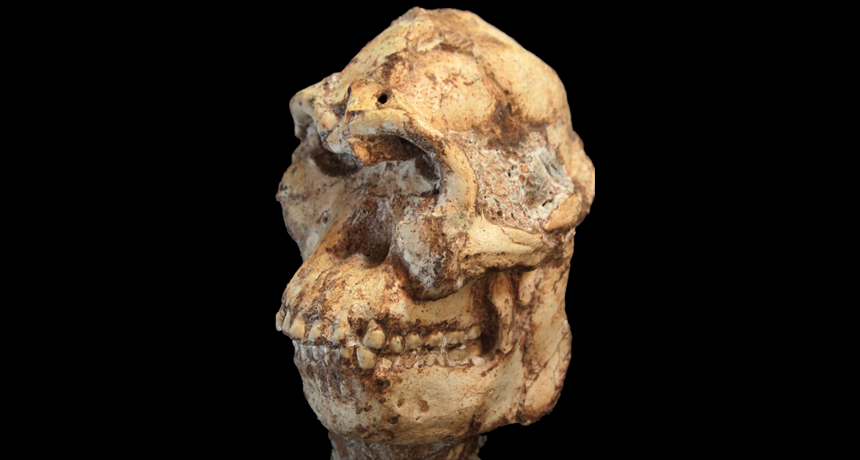‘Little Foot’ pushes back age of earliest South African hominids
New dating suggests species lived during same era as Lucy

OLD SOUTH Researchers have dated Little Foot, a South African fossil skeleton that includes this skull, to 3.67 million years ago. If the new age holds up, it makes Little Foot the oldest known hominid in that part of Africa.
Jason Heaton
Lucy’s species, an East African hominid line called Australopithecus afarensis, had a South African counterpart, a new study finds.
A nearly complete fossil skeleton from South Africa’s Sterkfontein Caves dates to 3.67 million years ago, making it roughly 1 million years older than any other South African hominid, say geochemist Darryl Granger of Purdue University in West Lafayette, Ind., and his colleagues. Dubbed Little Foot by one of its discoverers, the skeleton represents a species originally proposed for fossils at a nearby site in 1948, Australopithecus prometheus, the scientists contend in the April 2 Nature.
Previous estimates of the specimen’s age ranged from roughly 3 million to 2 million years ago. The new date, if correct, would make Little Foot contemporary with Lucy’s species, which lived in East Africa from about 4 million to 3 million years ago.
“Little Foot’s new date is a reminder that there could well have been many species of Australopithecus extending over a much wider area of Africa than just the small number of fossil sites in East Africa and South Africa,” says study coauthor Ronald Clarke, a paleoanthropologist at the University of the Witwatersrand in Johannesburg.
Clarke has worked since 1997 to free much of Little Foot’s skeleton from rock that had encased it (SN: 8/10/13, p. 29). Gradual sinking of cave sediments created gaps later filled by calcite deposits as water flowed down the walls or along the floor of the cave. That made it difficult to know whether Little Foot lay in rock from its own time or later.
Granger and his colleagues measured the decay of radioactive forms of aluminum and beryllium in 11 samples from quartz surrounding Little Foot’s skeleton. Decay of each element occurs at known rates shortly after sediment is buried. Nine of the 11 samples displayed comparable levels of decay, the researchers say, indicating that the rock was deposited on a single occasion.
Calculations based on decay rates of each radioactive substance produced the new age estimate.
Granger’s group used the same technique to date stone artifacts found elsewhere in Sterkfontein Caves to 2.18 million years ago. Stone tools at nearby South African sites also date to around 2 million years ago.
While sediment dates for the Sterkfontein artifacts appear solid, Little Foot may not be as old as the new report concludes, remarks geoarchaeologist Andy Herries of La Trobe University in Melbourne, Australia. “Few, if any,” fossil deposits in South Africa date to as early as 3.67 million years ago, says Herries, who has conducted dating studies at Sterkfontein and nearby caves. Rushing water or other natural events may have moved sediment dated by Granger’s team from an older to a younger part of the cave where Little Foot lay, Herries cautions.
“Little Foot is certainly somewhere between 3.7 million and 2.2 million years old,” he says.
Even if Little Foot lived 3.67 million years ago, “it’s interesting but hardly shocking that australopithecines might be that old in South Africa,” comments paleoanthropologist William Jungers of Stony Brook University in New York. Several Australopithecus species evolved in East Africa around that time, suggesting that other variants of the ancient genus could have emerged elsewhere in Africa, he says.
Clarke argues that Little Foot’s distinctively shaped molar teeth, flat face and other traits justify assigning it to a new species. But many researchers, including Herries and Jungers, classify hundreds of Australopithecus fossils recovered at Sterkfontein Caves, including those of Little Foot, as Australopithecus africanus. Sterkfontein’s A. africanus fossils are generally regarded as between 2.6 million and 2 million years old.
Editor’s note: This story was updated on April 2, 2015, to clarify the history of Little Foot’s species name, the difficulty in dating the fossil and the shape of Little Foot’s teeth.







